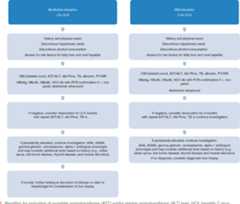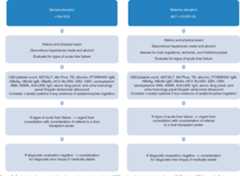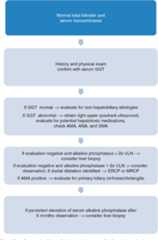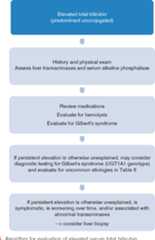- Corpus ID: 23788795
Clinical Guideline : Evaluation of Abnormal Liver Chemistries
@inproceedings{Kwo2016ClinicalG, title={Clinical Guideline : Evaluation of Abnormal Liver Chemistries}, author={Paul Yien Kwo and Faasld Facg and Stanley M. Cohen and Joseph K. Lim}, year={2016}, url={https://api.semanticscholar.org/CorpusID:23788795}}- P. KwoFaasld FacgJoseph K. Lim
- Published2016
- Medicine
A formal review and literature search of the world literature on MEDLINE and EMBASE databases dealing with the evaluation of abnormal liver chemistries, studies that dealt with normal or reference range for alanine aminotransferase (ALT) levels and what thresholds trigger an evaluation for actionable liver disease are found.
No Paper Link Available
815 Citations
Figures and Tables from this paper
815 Citations
Elevated Liver Enzymes in Asymptomatic Patients – What Should I Do?
A guide to primary care clinicians to interpret abnormal elevation of liver enzymes in asymptomatic patients using a step-wise algorithm is provided.
Transaminases: oldies but goldies. A narrative review.
Beside the role in the first diagnostic step of liver injuries, the utility of liver transaminases is also maintained during the follow-up of liver diseases and in their prognostic assessment.
Approach to Patients with Increased Liver Biochemical and Function Tests : A Literature Review
- Syifa MustikaCamoya GersomP. Kongkam
- 2025
Medicine
A wide range of liver diseases is discussed, with a focus on those exhibiting hepatocellular patterns, such as viral hepatitis, acute liver failure, fatty liver disease, and drug-induced liver injury (DILI), as well as other conditions like ischemic and autoimmune hepatitis.
Abnormal Liver Enzymes
- J. BianA. SchreinerD. Rockey
- 2019
Medicine
Close attention is needed for followups of evaluation of abnormal liver tests in order to make appropriate NAFLD diagnosis and to develop a corresponding management plan in primary care for monitoring disease progression, treating complications, and managing cardiovascular risks.
Evaluation of the Patient with Markedly Abnormal Liver Enzymes.
- Bethany A. ReutemannF. Gordon
- 2023
Medicine
When Do Clinicians Follow-up Abnormal Liver Tests in Primary Care?
- A. SchreinerJ. BianD. Rockey
- 2019
Medicine
Trends in Follow-Up Liver Chemistry Testing: A Retrospective Cohort Study
- A. Schreiner
- 2018
Medicine
The proportion of patients without repeat liver chemistries in response to initial abnormalities increased over the course of the past decade, and multiple factors may play a role in this observed…
...
92 References
AGA technical review on the evaluation of liver chemistry tests.
To provide high-quality, cost-effective health care, a rational approach for the appropriate evaluation of serum liver chemistries is essential for all practicing physicians.
Diagnosis and monitoring of hepatic injury. I. Performance characteristics of laboratory tests.
The international normalized ratio should not be the sole method for reporting results of prothrombin time in liver disease; additional research is needed to determine the reporting mechanism that best correlates with functional impairment.
Evaluation of abnormal liver-enzyme results in asymptomatic patients.
Now that routine laboratory testing is automated and is frequently part of an annual checkup, physicians are often faced with the problem of a patient with one abnormal result on measurement of serum…
Diagnosis and Monitoring of Hepatic Injury. II. Recommendations for Use of Laboratory Tests in Screening, Diagnosis, and Monitoring
Although ALT is useful for detecting acute and chronic hepatic injury, it is not related to severity of acute Hepatitis B and C and only weakly related to severe severity of chronic hepatics injury.
Liver enzyme alteration: a guide for clinicians
- E. GianniniR. TestaV. Savarino
- 2005
Medicine
Canadian Medical Association Journal
In this review, a schematic approach is used that classifies enzyme alterations as predominantly hepatocellular or predominantly cholestatic, and abnormal enzymatic activity within the 2 subgroups are reviewed.
Prevalence of Abnormal Liver Function Tests in Celiac Disease and the Effect of a Gluten-Free Diet in the US Population
- N. CastilloR. VangaD. Leffler
- 2015
Medicine
Forty percent of individuals will have elevated LFTs at CD diagnosis; however, the majority will normalize with standard CD therapy and should be checked in all patients with CD and coexisting liver disorder should be considered in patients whoseLFTs have not improved within a year on a GFD.
A practice guideline on Wilson disease
- E. RobertsM. Schilsky
- 2003
Medicine
These guidelines provide data-supported approaches to the diagnosis and management of patients with Wilson disease that are based on broad-based review of the published literature in pediatrics and medicine and 40 accumulated years of personal experience of the authors.
AGA technical review on nonalcoholic fatty liver disease.
- A. Sanyal
- 2002
Medicine
In this review, the existing literature regarding the nomenclature, clinical and histologic spectrum, natural history, diagnosis, and management of nonalcoholic fatty liver disease are discussed.
Introduction to the Revised American Association for the Study of Liver Diseases Position Paper on Acute Liver Failure 2011
- William M. LeeR. StravitzAnne Larson
- 2012
Medicine
Fulminant Wilson's disease can be diagnosed most effectively not by waiting for copper levels (too slow to obtain) or by obtaining ceruloplasmin levels (low in half of all ALF patients, regardless of etiology), but by simply looking for the more readily available bilirubin level and alkaline phosphatase (ALP; very low).
...
Related Papers
Showing 1 through 3 of 0 Related Papers












